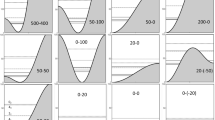Abstract
It has been shown that the description of the details of the electronic spectra obtained by the combination of the dynamical mean field theory, quantum Monte Carlo methods, and the maximum entropy method can be significantly improved by changing the last method to optimal regularization of the analytic continuation of the Green’s function to the real frequency axis. Starting with the quantum Monte Carlo data, this method has reconstructed peaks in the structure of Hubbard subbands with a maximum error of 0.001 to 0.01. Owing to the universality of the quantum Monte Carlo method, by varying hybridization, it is possible to determine the features of the hybridized function that are responsible for the formation of the structure of Hubbard subbands. It has been shown that there is no direct relation between the peak structure of subbands and the central Kondo peak. The result indicates the charge nature of resonances responsible for the formation of the peak structure.
Similar content being viewed by others
References
A. Georges, G. Kotliar, W. Krauth, and M. J. Rozenberg, Rev. Mod. Phys. 68, 13 (1996).
E. Gull, A. J. Millis, A. I. Lichtenstein, et al., Rev. Mod. Phys. 83, 349 (2011).
G. Kotliar, S. Y. Savrasov, K. Haule, et al., Rev. Mod. Phys. 78, 865 (2006).
X. Y. Zhang, M. J. Rozenberg, and G. Kotliar, Phys. Rev. Lett. 70, 1666 (1993).
M. Karski, C. Raas, and G. S. Uhrig, Phys. Rev. B 72, 113110 (2005).
M. Karski, C. Raas, and G. S. Uhrig, Phys. Rev. B 77, 075116 (2008).
M. Jarrell and J. E. Gubernatis, Phys. Rep. 269, 133 (1996).
A. N. Tikhonov and V. Ya. Arsenin, Solutions of Ill-Posed Problems, 3rd ed. (Nauka, Moscow, 1981; translation of the 1st ed.: Halsted, New York, 1977).
M. Ferrero and O. Parcollet, in preparation.
A. F. Albuquerque, F. Alet, P. Corboz, et al., J. Magn. Magn. Mater. 310, 1187 (2007).
B. Bauer, L. D. Carr, H. G. Evertz, et al., J. Stat. Mech. 2011, P05001 (2011).
P. Werner, A. Comanac, L. de’Medici, et al., Phys. Rev. Lett. 97, 076405 (2006).
L. Boehnke, H. Hafermann, M. Ferrero, et al., Phys. Rev. B 84, 075145 (2011).
Author information
Authors and Affiliations
Additional information
Original Russian Text © I.S. Krivenko, A.N. Rubtsov, 2011, published in Pis’ma v Zhurnal Eksperimental’noi i Teoreticheskoi Fiziki, 2011, Vol. 94, No. 10, pp. 832–837.
Rights and permissions
About this article
Cite this article
Krivenko, I.S., Rubtsov, A.N. Analysis of the nature of the peak structure of Hubbard subbands using the quantum Monte Carlo method. Jetp Lett. 94, 768–773 (2012). https://doi.org/10.1134/S0021364011220073
Received:
Published:
Issue Date:
DOI: https://doi.org/10.1134/S0021364011220073




